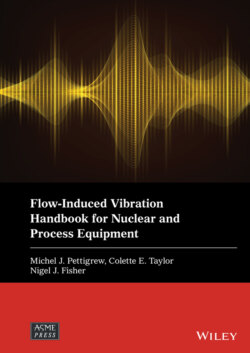Читать книгу Flow-Induced Vibration Handbook for Nuclear and Process Equipment - Группа авторов - Страница 41
Two‐Phase Cross Flow
ОглавлениеRandom turbulence excitation forces can be significant in two‐phase cross flow, in particular, in the U‐bend region of steam generators. The term turbulence is used loosely in two‐phase flows. It describes the dynamics of the two‐phase mixture as it flows through a tube bundle.
For void fractions of 10% or less, two‐phase flow random forces behave like single‐phase flow forces and the single‐phase guidelines can be used. At higher void fractions, the effect of the two‐phase mixture begins to dominate the single‐phase random forces. The physics of these two‐phase forces are not well understood but recent study of the effect of void fraction and flow regime have led to reasonable collapse of two‐phase data from air‐water, Freon liquid‐vapor, Freon vapor‐water and steam‐water experiments.
Preliminary two‐phase design guidelines for random excitation of heat exchanger tubes were presented by several authors such as Taylor et al (1989), Axisa et al (1990) and Taylor et al (1996). Most of this data was obtained with air‐water mixtures, with some steam‐water data. A few years later, de Langre and Villard (1998) introduced a dimensionless scaling that simplifies that suggested by Taylor et al (1996) and more closely follows the principle used in the scaling of single‐phase random forces.
De Langre and Villard (1998) show that a two‐phase power spectral density, , can be rendered dimensionless using Eq. (2-27) with a two‐phase pressure scaling factor, po = ρℓgDB, and a two‐phase frequency scaling factor, fo = Up/DB. The length scale, DB, is defined as follows:
(2‐33)
The selection of these scaling factors is described is some detail in de Langre and Villard (1998). Many pressure scaling factors were considered, but the gravity‐based factor was the most efficient. The authors point out that gravity in the scaling factor may be related to dynamic pressure caused by the drift velocities between gas and liquid phases. More recent analysis by Taylor and Pettigrew (2019) has shown that a two‐phase pressure scaling factor of po = ρℓgD is preferred.
Using these scaling factors and the reference EPSD described above in Eq. (2-30), data from many sources were collapsed on a single plot (see Fig. 2-15). The following boundary spectra for two‐phase random forces in churn and bubbly flow were defined by Taylor and Pettigrew (2019):
(2‐34)
Fig. 2-15 Proposed Guideline for Two‐Phase Random Excitation Forces In Churn and Bubbly Flow Regimes (Taylor and Pettigrew, 2019).
